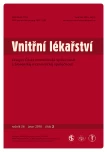Prevalence of rheumatic manifestations and non‑organ specific autoimmunity in patients with autoimmune thyreopathy
Authors:
K. Benhatchi 1; I. Lazúrová 1; D. Kozáková 2; J. Rovenský 2
Authors‘ workplace:
I. interná klinika Lekárskej fakulty UPJŠ a FN L. Pasteura Košice, Slovenská republika, prednostka prof. MU Dr. Ivica Lazúrová, CSc., 2Národný ústav reumatických chorôb Piešťany, Slovenská republika, riaditeľ prof. MU Dr. Jozef Rovenský, DrSc., FRCP
1
Published in:
Vnitř Lék 2010; 56(2): 106-110
Category:
Original Contributions
Overview
Introduction:
A variety of rheumatic manifestations (RM) has been described in association with autoimmune thyroiditis (AIT). In the past, most of these manifestations were attributed to the underlying thyroid dysfunction, in particular hypothyroidism. AIT is often associated with non‑organ specific autoimmunity. Increased prevalence of non‑organ specific autoantibodies in patients with AIT without any evidence of rhemautic manifestations is clinically unclear. Aim of this study was to find out the frequency of apperance of non‑organ specific antibodies in serum in patients with AIT and prevalence of RM (arthralgia/ arthitis). Patients and methods: The group consisted of 80 patients with diagnosis AIT. The diagnosis of AIT was made according to established criteria. This diagnosis was primarily based on laboratory markers including thyroid hormone levels (TSH, fT4, fT3), the detection of antithyroid antibodies (anti‑TPO, anti‑TG, anti‑RTSH antibodies) and on ultrasound examination (imaging signs of thyroid autoimmunity) of thyroidal gland. None of the above patients had a history of systemic autoimmune disorders. In the group of patients with AIT we evaluated the prevalence of non‑organ specific antibodies (ANA/ Hep 2, ENA scr., SSA, SSB, nRNP, dsDNA, DNP, RF, ACLA scr., ANCA/ MPO, ANCA/ PR3) and presence of RM (arthritis/ arthralgia). The control group consisted of 34 patients with no overt history of AIT or systemic autoimmune disorders. Results: In the group of patients with AIT ANA positivity was found in 36/ 80 (45%) patients compared with 5/ 34 (14.7%) in healthy controls (p < 0.05). The prevalence of ANA autoantibodies was significantly higher in patients with AIT than in healthy controls. Other levels of non‑organ specific antibodies (ENA scr., SSA, SSB, nRNP, dsDNA, DNP, RF, ACLA scr., ANCA/ MPO, ANCA/ PR3) were not significantly different among patients with AIT and healthy controls. 40/ 80 (50%) of patients with AIT had artralgia compared with 7/ 34 (20.6%) in healthy controls (p < 0.05) and 19/ 80 (23.75%) of patients with AIT had arthritis compared with 1/ 34 (2.9%) in healthy controls (p < 0.05). The prevalence of RM (arthralgia and arthritis) in group of patients with AIT was significantly higher than in healthy controls. Conclusion: The prevalence of ANA autoantibodies and RM (arthralgia/ arthritis – both) was significantly higher in patients with AIT than in healthy controls.
Key words:
autoimmune thyreopathy – non‑organ specific autoantibodies – connective tissue diseases – rheumatic manifestations
Sources
1. Osundeko O, Hasinski S, Rose L. Anti‑cardiolipin antibodies in Hashimoto’s disease. Endocr Pract 2001; 7: 181– 183.
2. Punzi L, Batterle C. Chronic autoimmune thyroiditis and rheumatic manifestations. Joint Bone Spine 2004; 71: 275– 283.
3. Morita S, Arima T, Matsuda M. Prevalence of nonthyroid specific autoantibodies in autoimmune thyroid disease. J Clin Endocrinol Metab 1995; 80: 1203– 1206.
4. Guerin V, Bene MC, Barbe F et al. Stigmates autoimmunitaires thyroidiens au cours de la polyarthrite rhumatoide. Rev Rhum 1987; 54: 438.
5. Tektonidou MG, Anapliotou M, Vlachoyiannopoulos P et al. Presence of systematic autoimmune disorders in patiens with autoimmune thyroid diseases. Ann Rheum Dis 2004; 63: 1159– 1161.
6. Šterzl I, Hrdá P, Matucha P et al. Polyglandulární aktivace autoimunity jako projev subklinických endokrinopatií. Čas Lék Čes 2007; 146: 256– 261.
7. Guerin V, Prestat F, Bene MC et al. Prevalence of non‑thyroid autoantibodies in autoimmune dysthyroidies. Ann Endocrinol 1989; 50: 477– 482.
8. Weetman A. Non‑ thyroid autoantibodies in autoimmune thyroid disease. Best Practice and Research Clin Endocrinology and Metabolism 2005; 19: 17– 32.
9. Hansen BU, Ericsson UB, Henricsson V et al. Autoimmune thyroiditis and primary Sjogren’s syndrome: clinical and laboratory evidence of the coexistence of the two diseases. Clin Exp Rheumatol 1991; 9: 137– 141.
10. Katakura M, Yamada T, Aizawa T et al. Presence of antideoxyribonucleic acid antibody in patients with hyperthyroidism of Grave’s disease. J Clin Endocrinol Metab 1987; 64: 405– 408.
11. McDermott MT, West SG, Emlen JW et al. Antideoxyribonucleic acid antibodies in Grave’s disease. J Clin Endocrinol Metab 1990; 71: 509– 511.
12. Baethge BA, Levine SN, Wolf RE. Antibodies to nuclear antigens in Grav’s disease. J Clin Endocrinol Metab 1988; 66: 485– 488.
13. Loviselli A, Velluzzi F, Pala R et al. Circulating antibodies to DNA‑related antigens in patients with autoimmune thyroid disorders. Autoimmunity 1992; 14: 33– 36.
14. Paggi A, Caccavo D, Ferri GM et al. Anti‑cardiolipin antibodies in autoimmune thyroid diseases. Clin Endocrinol 1994; 40: 329– 333.
15. Petri M, Karlson EW, Cooper DS et al. Antibody tests in autoimmune thyroid disease: a case‑ control study. J Rheumatol 1991; 18: 1529– 1531.
16. Punzi L, Michelotto M, Pianon M et al. Clinical, laboratory and immunogenetic aspects of arthritis associated with chronic lymfocytic thyroiditis. Clin Exp Rheumatol 1997; 15: 373– 380.
17. Blake DR, McGregor AM, Stansfield E et al. Antithyroid‑ antibodies activity in the synovial fluid of patients with various arthritides. Lancet 1979; 2: 224– 226.
Labels
Diabetology Endocrinology Internal medicineArticle was published in
Internal Medicine

2010 Issue 2
Most read in this issue
- Central diabetes insipidus in adult patients – the first sign of Langerhans cell histiocytosis and Erdheim‑Chester disease. Three case studies and literature review
- Risk of long‑term antisecretory treatment with proton pump inhibitors
- A case study of a young male patient with subacute constrictive pericarditis
- Direct renin inhibitor aliskiren in the treatment of cardiovascular and renal diseases
